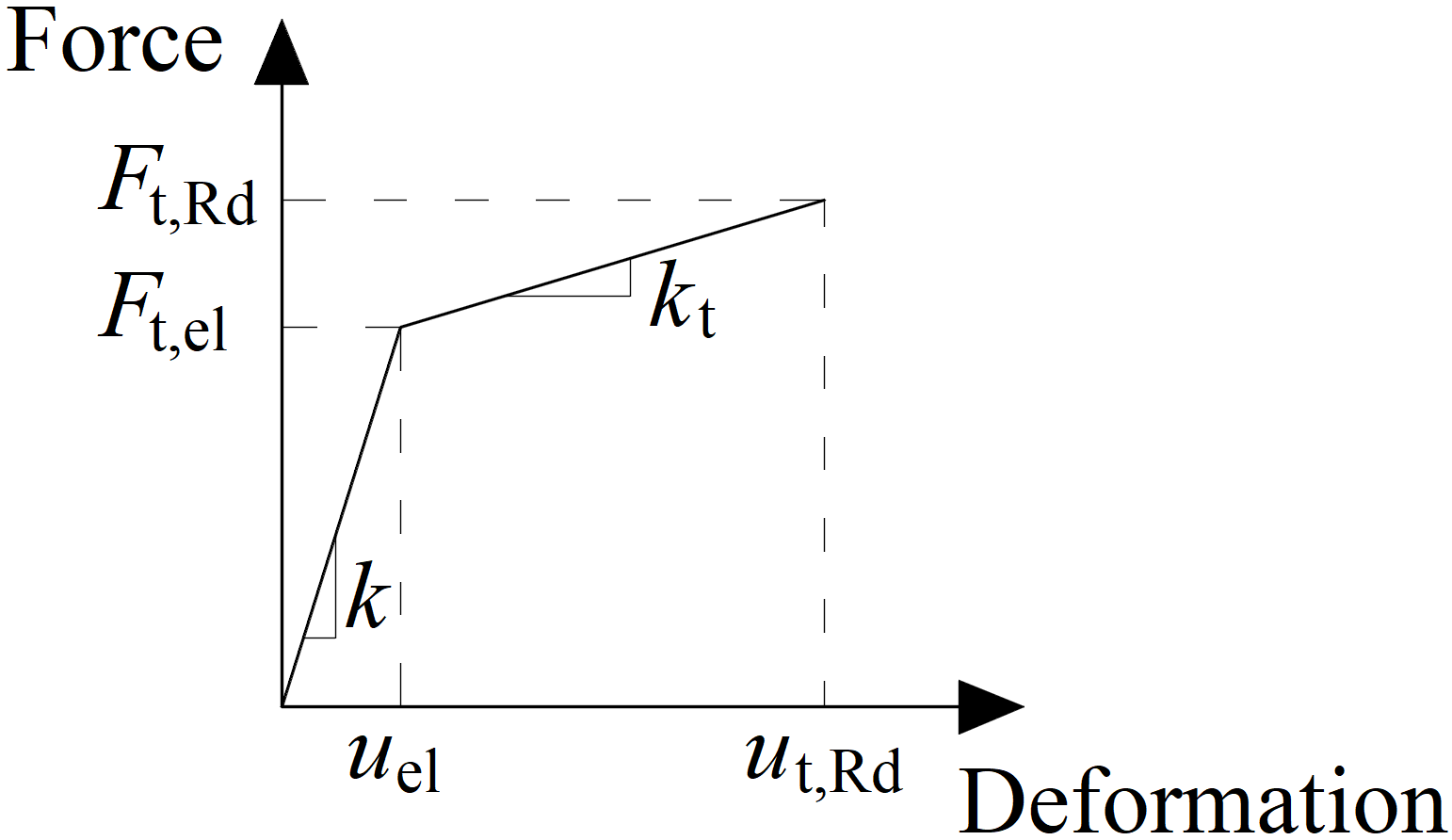Bouten en voorgespannen boutverbindingen
Bouten
In de Component-Based Finite Element Method (CBFEM) is de bout met zijn gedrag in trek, afschuiving en stuik de component die wordt beschreven door de afhankelijke niet-lineaire veren. De boutsamenstelling bestaat uit bout, ring en moer en wordt gesimuleerd door een niet-lineaire veer, stijf lichaamselementen en spelingselementen.
Bout in trek
De bout in trek wordt beschreven door een veer met zijn initiële axiale stijfheid, ontwerpsweerstand, initialisatie van vloeien en vervormingscapaciteit. De initiële axiale stijfheid wordt analytisch afgeleid in de richtlijn VDI2230 en in Agerskov (1976).
\[D_{Lb} =\frac{L_s+0.4d_b}{EA_{ss}}\]
\[A_{pp}=\frac{0.75D_H(L_w-D_H)}{D_{W1}^2-D_{W2}^2}\]
\[A_{P1}=\frac{\pi}{4}(D_H^2-D_{W1}^2)\]
\[A_{P2}=\frac{1}{2}(D_{W2}^2-D_H^2)\tan^{-1}A_{pp}\]
\[A_P=A_{P1}+A_{P2}\]
\[D_{LW}=\frac{L_W}{EA_P}\]
\[k=\frac{1}{D_{LB}+D_{LW}}\]
waarbij:
- \(d_b\) – boutdiameter
- \(D_H\) – kopdiameter
- \(D_{W1}\) – binnen ringdiameter
- \(D_{W2}\) – buitenste ringdiameter
- \(L_W\) – ringdikte
- \(L_s\) – bout grip lengte
- \(A_{ss}\) – bout brutto oppervlak
- \(E\) – elasticiteitsmodulus
Het model komt overeen met experimentele gegevens; zie Gödrich et al. (2014). Voor de initialisatie van vloeien en vervormingscapaciteit wordt aangenomen dat plastische vervorming alleen optreedt in het schroefdraadgedeelte van de boutschacht.
Kracht-vervormingsdiagram voor het dragen van de plaat
Het kracht-vervormingsdiagram wordt geconstrueerd met behulp van de volgende vergelijkingen:
Plastische stijfheid:
\[ k_t = c_1 k \]
Kracht op de elasticiteitsgrens:
\[ F_{t,el} = \frac{F_{t,Rd}}{c_1 c_2 - c_1 +1} \]
Vervorming bij elasticiteitsgrens:
\[ u_{el} = \frac{ F_{t,el} }{k} \]
Vervorming bij plastische grens:
\[ u_{t,Rd} = c_2 u_{el} \]
\[ c_1 = \frac{f_{ub} - f_{yb}}{\frac{1}{4} A E - f_{yb}} \]
\[ c_2 = \frac{AE}{4 f_{yb}} \]
waarbij:
- \(F_{t,Rd}\) – ontwerpweerstand van bout in trek
- \(f_{yb}\) – vloeigrens van de bout
- \(f_{ub}\) – uiterste treksterkte van de bout
- \(A\) – verlenging na de breuk
Bout in afschuiving
Alleen de drukkracht wordt overgebracht van de boutschacht naar de plaat in het boutgat. Deze wordt gemodelleerd door interpolatieverbindingen tussen de schachtknooppunten en de randknooppunten van de gaten. De vervormingsstijfheid van het schaalelement dat de platen modelleert, verdeelt de krachten tussen de bouten en simuleert de adequate draging van de plaat.
Boutgaten worden beschouwd als standaard (default) of slobgaten (kan ingesteld worden in de plaatbewerker). Bouten in standaardgaten kunnen dwarskracht in alle richtingen overbrengen, bouten in slobgaten hebben één richting uitgesloten en kunnen vrij in deze geselecteerde richting bewegen.
De initiële stijfheid en de ontwerpweerstand van een bout in afschuiving worden gedefinieerd door de volgende formules:
\[k_{el}=\frac{1}{\frac{1}{k_{11}}+\frac{1}{k_{12}}}\]
\[k_{11} = \frac{8d_b^2f_{ub}}{d_{M16}}\]
\[k_{12}=12k_td_bf_{up}\]
\[k_t=\min \left ( 2.5,\, \frac{1.5t_{min}}{d_{M16}} \right ) \]
\[k_{pl}=\frac{k_{el}}{1000}\]
waarbij:
- \(d_b\) – boutdiameter
- \(f_{ub}\) – uiterste boutsterkte
- \(d_{M16}=16 \textrm{ mm}\) – diameter van de referentiebout M16
- \(f_{up}\) – uiterste sterkte van de verbonden plaat
- \(t_{min}\) – minimale dikte van de verbonden plaat
De veer die de bout in afschuiving voorstelt, heeft een bi-lineair krachtvervormingsgedrag. Initialisatie van vloeien wordt verwacht bij:
\[F_{V,el}=0.999 F_{V,Rd}\]
De vervormingscapaciteit wordt beschouwd als:
\[\delta_{pl}=\delta_{el}\]
waarbij:
- \(F_{V,el}\) – elastische weerstand bout in afschuiving
- \(F_{V,Rd}\) – weerstand bout in afschuiving
- \(\delta_{el}\) – elastische vervorming bout in afschuiving
Interactie tussen trek en afschuiving
De interactie tussen de axiale kracht en de dwarskracht kan direct in het rekenmodel worden ingevoerd. De verdeling van de krachten komt beter overeen met de werkelijkheid (zie bijgevoegd diagram). Bouten met een hoge trekkracht nemen minder afschuifkracht op en omgekeerd.
Voorbeeld van de interactie van axiale en dwarskracht (EC)
Voorgespannen bouten
Voorgespannen bouten worden gebruikt wanneer een minimale vervorming nodig is. Het trekmodel van een bout is hetzelfde als voor standaardbouten. De dwarskracht wordt niet overgebracht via stuiken maar via wrijving tussen de geklemde platen.
De ontwerp slipweerstand van een voorgespannen bout wordt beïnvloed door een toegepaste trekkracht.
IDEA StatiCa Connection controleert de voorslipping grenstoestand van voorgespannen bouten. Als er een slipeffect optreedt, voldoen de bouten niet aan de controle. Dan moet de post-slipping grenstoestand worden gecontroleerd als een standaard oplegcontrole van bouten waarbij boutgaten dragend worden belast en bouten in afschuiving.
De gebruiker kan bepalen welke grenstoestand wordt gecontroleerd. Of het nu gaat om de weerstand tegen grote slip of de post-slipping toestand in afschuiving van bouten. Beide controles op één bout worden niet gecombineerd in één oplossing. Er wordt aangenomen dat de bout na een grote slip een standaard gedrag vertoont en kan worden gecontroleerd met de standaard oplegprocedure.
De momentlast van de verbinding heeft een kleine invloed op de afschuifcapaciteit. Toch wordt een wrijvingscontrole op elke bout afzonderlijk opgelost. Deze controle is geïmplementeerd in de FEM-component van de bout. Er is geen algemene informatie beschikbaar over de vraag of de externe trekbelasting van elke bout afkomstig is van het buigmoment of van de trekbelasting van de verbinding.
Spanningsverdeling in standaard schuifboutverbinding
Spanningsverdeling in slip-sterke schuifboutverbinding






